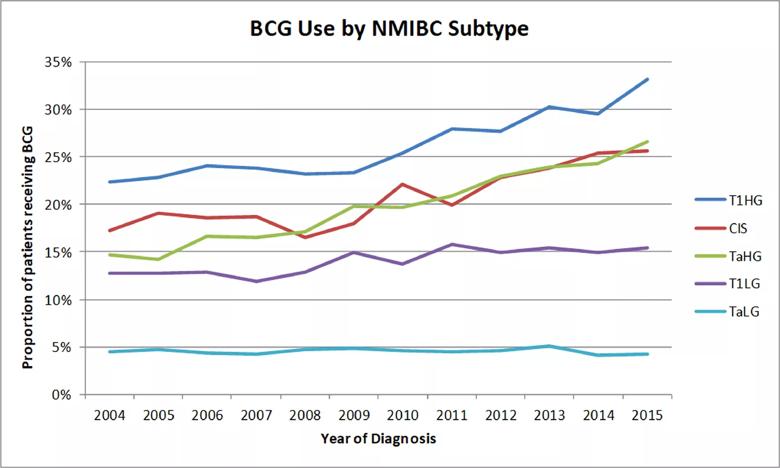Study highlights need for mitigation strategies

Interruptions in the supply of the non-muscle invasive bladder cancer (NMIBC) immunotherapy Bacillus Calmette-Guerin (BCG) in 2012 significantly impacted patient management, apparently causing clinicians to deviate from standards of care and ration the agent based on clinical risk.
Advertisement
Cleveland Clinic is a non-profit academic medical center. Advertising on our site helps support our mission. We do not endorse non-Cleveland Clinic products or services. Policy
That sobering finding comes from the first study to empirically assess BCG utilization trends following distribution shortages, which are an intensifying concern. The results highlight the need for mitigation strategies to deal with likely future BCG scarcity, the authors conclude.
The BCG utilization research, using the National Cancer Database, was conducted by Cleveland Clinic’s Glickman Urological & Kidney Institute and published recently in Urology.
“Bacillus Calmette-Guerin shortages have been a real challenge for urologists in the past, because we utilize BCG so often in NMIBC and shortages leave us with very few treatment options,” says study co-author and urologic oncologist Robert Abouassaly, MD.
“The aim of our study was to explore how BCG shortages affect the treatment of patients with NMIBC, so that we may more effectively prepare for any supply shortages in the future,” he says.
BCG — a live, attenuated strain of Mycobacterium bovis, the causative agent of tuberculosis in cattle — is a highly effective immunotherapy for NMIBC, with demonstrated superiority to other intravesical therapies in reducing disease recurrence and progression among high-risk patients.
“In patients with high-risk disease, BCG has been the mainstay treatment and is typically delivered as a six-week induction course, followed by maintenance BCG therapy for three years afterward,” Dr. Abouassaly says. “In this population of patients, BCG has been shown to be effective at decreasing recurrence rates by about 50 to 70 percent, as well as decreasing the risk of disease progression. Bacillus Calmette-Guerin works as an immune modulator – it produces a T cell response and stimulates the immune system to combat the cancer cells.”
Advertisement
A number of prior studies have documented increasing BCG use at individual medical centers over time, as more clinicians have adopted National Comprehensive Cancer Network treatment guidelines recommending intravesical BCG over chemotherapy for high-risk NMIBC patients.
The Cleveland Clinic study validated that usage trend, finding a significant overall increase in BCG utilization nationally between 2004 and 2015, based on an analysis of 238,279 patients diagnosed with NMIBC. A total of 33,660 patients (14.1 percent) received intravesical BCG in the study period. The proportion of patients receiving BCG nearly doubled during the decade, the study found, rising from 10 percent to 18 percent.
But supply interruptions and uncertainties took a demonstrable toll on BCG utilization and case management.
In 2012, Sanofi Pasteur, one of only two BCG suppliers to the United States, halted production of the Connaught BCG strain at its Toronto manufacturing facility after the U.S. Food and Drug Administration cited numerous regulatory violations. The shutdown lasted more than two years. The other U.S. BCG supplier, Merck, which manufactures the less clinically effective Tice strain, experienced its own manufacturing problems in 2012, exacerbating BCG shortages.
Not surprisingly, BCG use stagnated following the supply interruptions. The pre-shortage annual growth rate of 0.62 percent was halved to 0.29 percent per year between 2013 and 2015, the Cleveland Clinic study found.

Figure 1. Trends in BCG utilization before and after supply shortages. From Khanna A, Yerram N, Zhu H, et al. Utilization of Bacillus Calmette-Guerin for Nonmuscle Invasive Bladder Cancer in an Era of Bacillus Calmette-Guerin Supply Shortages. Urology. 2018 Sep 13 [Epub ahead of print]. © Elsevier, Inc. Used with permission.
Advertisement
Sub-analysis of the data indicates that clinicians were preferentially rationing BCG based on patients’ oncologic risk. In 2013-2015, following the supply interruptions, the study found that BCG use decreased most significantly among the lowest-risk NMIBC patient sub-group (Ta-low grade), while utilization notably increased for the highest-risk (T1-high grade) sub-group.

Figure 2. Trends in BCG use by tumor stage. From Khanna A, Yerram N, Zhu H, et al. Utilization of Bacillus Calmette-Guerin for Nonmuscle Invasive Bladder Cancer in an Era of Bacillus Calmette-Guerin Supply Shortages. Urology. 2018 Sep 13 [Epub ahead of print]. © Elsevier, Inc. Used with permission.
“Taken together, these findings may suggest that when faced with limited supply of BCG, urologists preferentially offered it to those at highest risk, while limiting its use in those with least aggressive disease,” Dr. Abouassaly and his co-authors wrote.
Although some leading urologists had advocated lowering the threshold for early radical cystectomy for NMIBC as a way of coping with BCG unavailability, the data showed no increase in the surgical procedure during the study period. The authors say that may reflect clinicians’ reluctance to expose patients to life-altering surgery and morbidity as an up-front treatment they would not ordinarily undergo.
Intriguingly, the researchers found that specific socioeconomic factors, including Hispanic ethnicity, nonwhite race, female gender and lack of health insurance were associated with decreased likelihood of BCG use, while patients with higher education or private health insurance were more likely to receive BCG. Determining the cause of those disparities was beyond the study’s scope but merits further inquiry, the authors wrote.
Advertisement
The study results reiterate the need to address BCG supply shortages, the authors say. Additional shortages are imminent, considering Sanofi Pasteur’s 2017 decision to permanently cease production of the Connaught BCG strain. That leaves Merck’s Tice strain (which produced inferior five-year recurrence-free survival results compared with the Connaught strain) as the only commercially available agent in the U.S. The reduced availability likely will have profound impacts on BCG treatment patterns.
Current coping strategies include dividing an individual BCG dose into thirds, so that it can be used for three patients, Dr. Abouassaly says, or using alternatives such as intravesical chemotherapy.
However, he stresses that developing novel treatments is vital.
“The NMIBC field of urology is lacking in drug development and clinical trials, and the oncology community really needs to come together to move the science forward and develop newer and more effective drugs,” Dr. Abouassaly says.
A phase 3 trial examining the efficacy of the Tokyo-172 BCG strain is underway at multiple U.S. medical centers, while the Moreau BCG strain was recently introduced in Europe and has preliminarily shown favorable five-year recurrence and progression outcomes.
Regulatory reform also is essential to address BCG shortages, Dr. Abouassaly and his co-authors say, such as tax credits or lending to incentivize BCG manufacturers, increasing Medicare fees for coverage of BCG, or allowing imports of internationally produced BCG.
Advertisement
Advertisement

Reconsidering axillary lymph node dissection as well as depth of surgical margins

Researchers uncover profound differences in the mechanism of action between different PD-L1 checkpoint inhibitors

A multi-pronged strategy for tackling cancer access problems

Early results show patients experiencing deep and complete response

Inclusion of genomic profiling and risk factors recommended for treatment planning

Collaborative research effort underscores the urgent need for effective second-line therapies in this rare, aggressive cancer

Largest study to date comparing direct-acting oral anticoagulants to low-molecular-weight heparin

Treatment assigned FDA review date in June 2025